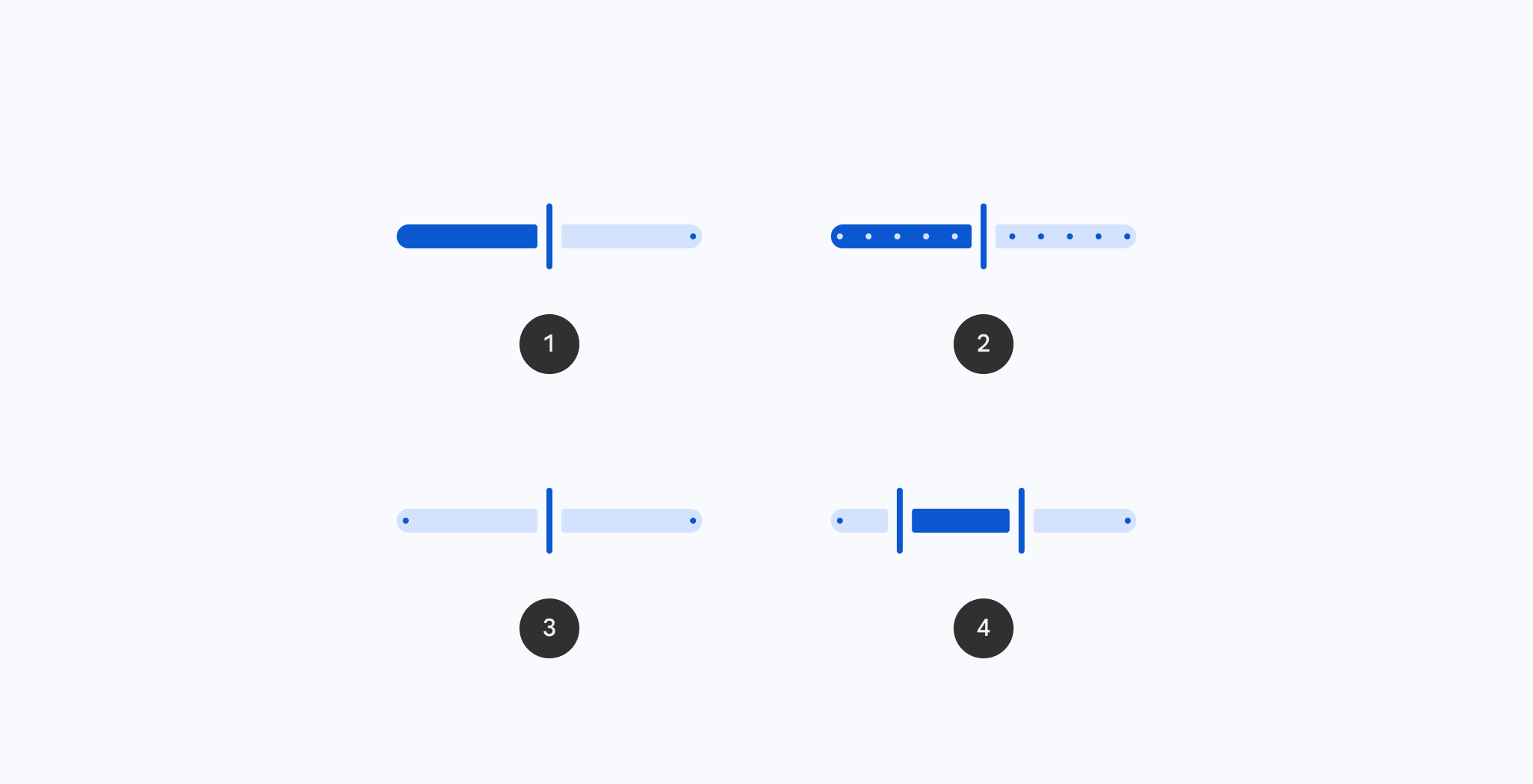VerticalSlider
Common
Component in Material 3 Compose
Vertical Sliders allow users to make selections from a range of values.
Vertical Sliders reflect a range of values along a vertical bar, from which users may select a single value. They are ideal for adjusting settings such as volume, brightness, or applying image filters.

Last updated:
Installation
dependencies {
implementation("androidx.compose.material3:material3:1.4.0-alpha17")
}
Overloads
@OptIn(ExperimentalMaterial3Api::class)
@ExperimentalMaterial3ExpressiveApi
@Composable
fun VerticalSlider(
state: SliderState,
modifier: Modifier = Modifier,
enabled: Boolean = true,
reverseDirection: Boolean = false,
colors: SliderColors = SliderDefaults.colors(),
interactionSource: MutableInteractionSource = remember { MutableInteractionSource() },
thumb: @Composable (SliderState) -> Unit = { sliderState ->
SliderDefaults.Thumb(
interactionSource = interactionSource,
sliderState = sliderState,
colors = colors,
enabled = enabled,
thumbSize = VerticalThumbSize,
)
},
track: @Composable (SliderState) -> Unit = { sliderState ->
SliderDefaults.Track(
colors = colors,
enabled = enabled,
sliderState = sliderState,
trackCornerSize = Dp.Unspecified,
)
},
)
Parameters
| name | description |
|---|---|
state | [SliderState] which contains the slider's current value. |
modifier | the [Modifier] to be applied to this slider |
enabled | controls the enabled state of this slider. When false, this component will not respond to user input, and it will appear visually disabled and disabled to accessibility services. |
reverseDirection | controls the direction of this slider. Default is top to bottom. |
colors | [SliderColors] that will be used to resolve the colors used for this slider in different states. See [SliderDefaults.colors]. |
interactionSource | the [MutableInteractionSource] representing the stream of [Interaction]s for this slider. You can create and pass in your own remembered instance to observe [Interaction]s and customize the appearance / behavior of this slider in different states. |
thumb | the thumb to be displayed on the slider, it is placed on top of the track. The lambda receives a [SliderState] which is used to obtain the current active track. |
track | the track to be displayed on the slider, it is placed underneath the thumb. The lambda receives a [SliderState] which is used to obtain the current active track. |
Code Examples
VerticalSliderSample
@OptIn(ExperimentalMaterial3Api::class, ExperimentalMaterial3ExpressiveApi::class)
@Preview
@Composable
fun VerticalSliderSample() {
val coroutineScope = rememberCoroutineScope()
val sliderState =
rememberSliderState(
// Only allow multiples of 10. Excluding the endpoints of `valueRange`,
// there are 9 steps (10, 20, ..., 90).
steps = 9,
valueRange = 0f..100f,
)
val snapAnimationSpec = MaterialTheme.motionScheme.fastEffectsSpec<Float>()
var currentValue by rememberSaveable { mutableFloatStateOf(sliderState.value) }
var animateJob: Job? by remember { mutableStateOf(null) }
sliderState.shouldAutoSnap = false
sliderState.onValueChange = { newValue ->
currentValue = newValue
// only update the sliderState instantly if dragging
if (sliderState.isDragging) {
animateJob?.cancel()
sliderState.value = newValue
}
}
sliderState.onValueChangeFinished = {
animateJob =
coroutineScope.launch {
animate(
initialValue = sliderState.value,
targetValue = currentValue,
animationSpec = snapAnimationSpec,
) { value, _ ->
sliderState.value = value
}
}
}
val interactionSource = remember { MutableInteractionSource() }
Column(modifier = Modifier.padding(horizontal = 16.dp)) {
Text(
modifier = Modifier.align(Alignment.CenterHorizontally),
text = "%.2f".format(sliderState.value),
)
Spacer(Modifier.height(16.dp))
VerticalSlider(
state = sliderState,
modifier =
Modifier.height(300.dp)
.align(Alignment.CenterHorizontally)
.progressSemantics(
currentValue,
sliderState.valueRange.start..sliderState.valueRange.endInclusive,
sliderState.steps,
),
interactionSource = interactionSource,
track = {
SliderDefaults.Track(
sliderState = sliderState,
modifier = Modifier.width(36.dp),
trackCornerSize = 12.dp,
)
},
reverseDirection = true,
)
}
}
VerticalCenteredSliderSample
@OptIn(ExperimentalMaterial3Api::class, ExperimentalMaterial3ExpressiveApi::class)
@Preview
@Composable
fun VerticalCenteredSliderSample() {
val coroutineScope = rememberCoroutineScope()
val sliderState =
rememberSliderState(
// Only allow multiples of 10. Excluding the endpoints of `valueRange`,
// there are 9 steps (10, 20, ..., 90).
steps = 9,
valueRange = -50f..50f,
)
val snapAnimationSpec = MaterialTheme.motionScheme.fastEffectsSpec<Float>()
var currentValue by rememberSaveable { mutableFloatStateOf(sliderState.value) }
var animateJob: Job? by remember { mutableStateOf(null) }
sliderState.shouldAutoSnap = false
sliderState.onValueChange = { newValue ->
currentValue = newValue
// only update the sliderState instantly if dragging
if (sliderState.isDragging) {
animateJob?.cancel()
sliderState.value = newValue
}
}
sliderState.onValueChangeFinished = {
animateJob =
coroutineScope.launch {
animate(
initialValue = sliderState.value,
targetValue = currentValue,
animationSpec = snapAnimationSpec,
) { value, _ ->
sliderState.value = value
}
}
}
val interactionSource = remember { MutableInteractionSource() }
Column(modifier = Modifier.padding(horizontal = 16.dp)) {
Text(
modifier = Modifier.align(Alignment.CenterHorizontally),
text = "%.2f".format(sliderState.value),
)
Spacer(Modifier.height(16.dp))
VerticalSlider(
state = sliderState,
modifier =
Modifier.height(300.dp)
.align(Alignment.CenterHorizontally)
.progressSemantics(
currentValue,
sliderState.valueRange.start..sliderState.valueRange.endInclusive,
sliderState.steps,
),
interactionSource = interactionSource,
track = { SliderDefaults.CenteredTrack(sliderState = sliderState) },
reverseDirection = true,
)
}
}